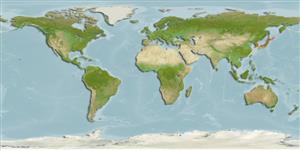Environment: milieu / climate zone / depth range / distribution range
Ecología
marino demersal; rango de profundidad 0 - 20 m (Ref. 50610). Temperate
Northwest Pacific: southern Kuril Islands, Aniva Bay, Japan from Hokkaido to northern Honshu, Japan Sea from Tatar Strait to Korean Peninsula; Yellow Sea at Chefoo and Gulf of Pohai.
Tamaño / Peso / Age
Maturity: Lm ? range ? - ? cm
Max length : 10.0 cm SL macho / no sexado; (Ref. 43239); common length : 5.0 cm TL macho / no sexado; (Ref. 56557)
Short description
Claves de identificación | Morfología | Morfometría
Espinas dorsales (total) : 55 - 59; Radios blandos dorsales (total) : 0; Espinas anales: 1; Radios blandos anales: 39 - 41; Vértebra: 60 - 64.
Found in tide pools of rocky shores, among rocks and seaweed beds in bays (Ref. 43239). Oviparous, eggs are guarded by the female parent (Ref. 58332).
Life cycle and mating behavior
Maturities | Reproducción | Spawnings | Egg(s) | Fecundities | Larva
Masuda, H., K. Amaoka, C. Araga, T. Uyeno and T. Yoshino, 1984. The fishes of the Japanese Archipelago. Vol. 1. Tokai University Press, Tokyo, Japan. 437 p. (text). (Ref. 559)
IUCN Red List Status (Ref. 130435)
Threat to humans
Harmless
Human uses
Herramientas
Special reports
Download XML
Fuentes de Internet
Estimates based on models
Preferred temperature (Ref.
123201): 8.5 - 20, mean 15.2 °C (based on 167 cells).
Phylogenetic diversity index (Ref.
82804): PD
50 = 0.5156 [Uniqueness, from 0.5 = low to 2.0 = high].
Bayesian length-weight: a=0.01000 (0.00244 - 0.04107), b=3.04 (2.81 - 3.27), in cm total length, based on all LWR estimates for this body shape (Ref.
93245).
Nivel trófico (Ref.
69278): 3.1 ±0.4 se; based on size and trophs of closest relatives
Resiliencia (Ref.
120179): Medio, población duplicada en un tiempo mínimo de 1.4-4.4 años (Preliminary K or Fecundity.).
Fishing Vulnerability (Ref.
59153): Low vulnerability (10 of 100).
